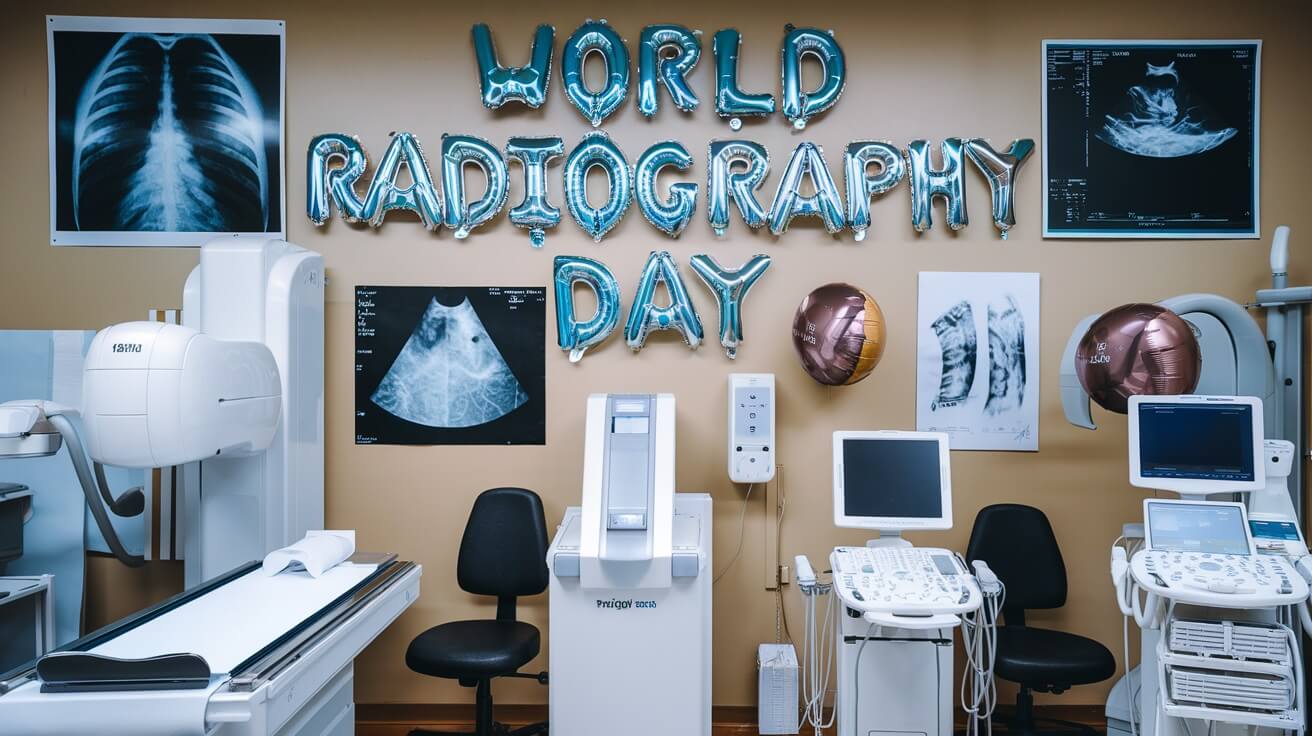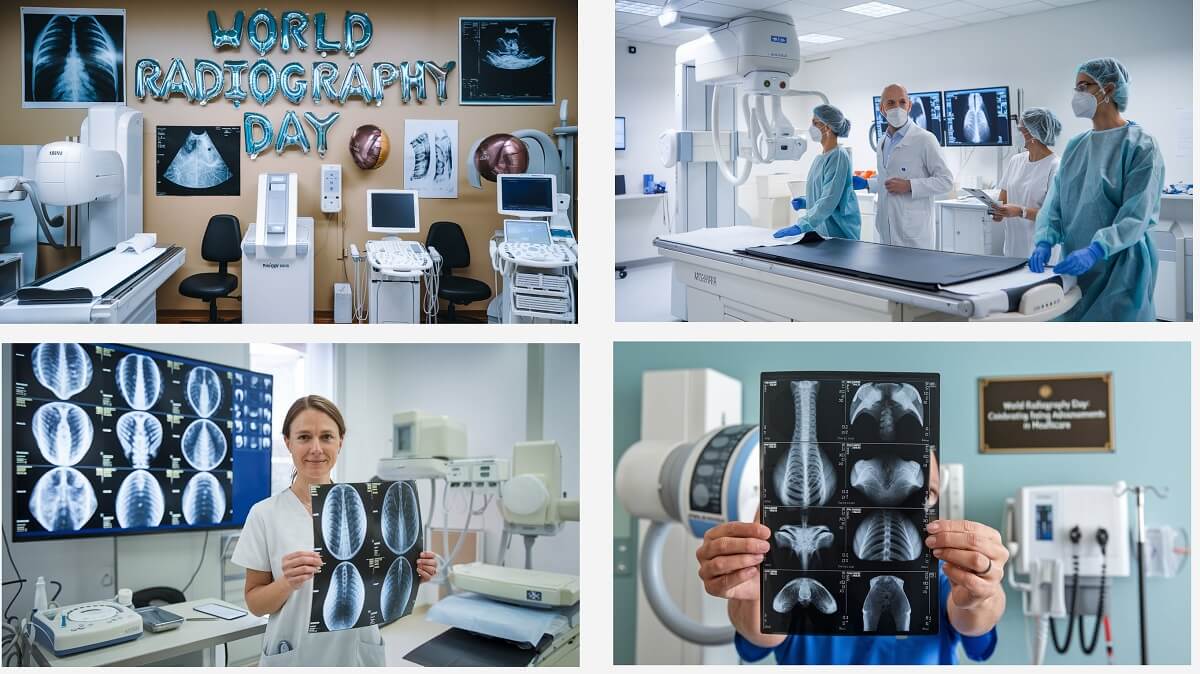
World Radiography Day: Celebrating the Impact of Medical Imaging in Healthcare
Introduction
Have you ever wondered how doctors can see inside the body and diagnose injuries or illnesses without surgery? Radiography, the field behind imaging technologies like X-rays and CT scans, makes it possible. World Radiography Day, observed each year on November 8, commemorates Wilhelm Roentgen's groundbreaking discovery of X-rays in 1895.
This day honors an incredible milestone in medical history and highlights the ongoing contributions of radiographers, the professionals who operate imaging technology to support diagnostics and patient care.
Radiography might sound technical, but it affects almost everyone at some point. From a simple dental X-ray to a complex CT scan, these images are vital for doctors in diagnosing and monitoring health conditions. However, many people still need to learn about what radiography entails, its safety, and its significance.
This article dives deep into the world of radiography—exploring its history, role in healthcare, Radiology Day celebration ideas, and reasons for celebrating World Radiography Day. Let's begin to understand an often underappreciated field that saves lives daily.
Discovery of X-rays by Wilhelm Roentgen
Imagine a time when doctors had no way of viewing bones or organs without making incisions. This changed dramatically in 1895 when Wilhelm Roentgen, a German physicist, accidentally discovered X-rays. He found that certain invisible rays could pass through objects, including the human body, and create images on photographic plates. The first X-ray image was of his wife's hand, showing her bones and wedding ring. This discovery was groundbreaking, offering a non-invasive way to see inside the body.
Evolution of Radiography in Medicine
Since that first discovery, radiography has rapidly evolved. Early X-rays were quite rudimentary and often exposed patients to high levels of radiation. However, technology and safety protocols have greatly improved over time.
Modern radiography now includes various techniques, from digital X-rays to complex imaging methods like MRI (Magnetic Resonance Imaging) and CT (Computed Tomography) scans. These advancements allow healthcare providers to diagnose diseases accurately, monitor health conditions, and even guide specific treatments without surgery. To ensure patient safety during these procedures, healthcare professionals often use a lead apron to protect against unnecessary radiation exposure.
Establishing World Radiography Day
World Radiography Day commemorates Roentgen's discovery and honors radiographers worldwide. Celebrated on November 8, this day educates the public about radiography's essential role in healthcare and promotes safe and effective practices within the field. It's a day to reflect on how far radiography has come and recognize the people who make it all possible—radiographers who work tirelessly to ensure accurate and safe patient imaging.

Why Radiography is Important in Healthcare
Essential Tool for Diagnosis
Radiography plays an essential role in diagnosing countless conditions. Imagine trying to diagnose a fractured bone, a tumor, or pneumonia without imaging. Radiography provides detailed internal images that help doctors see what's happening inside the body. This is especially valuable for conditions with few external symptoms but can be identified through imaging, such as lung infections or kidney stones.
Innovations in Medical Imaging
With technological advances, radiography has become more precise and efficient. Digital imaging, for instance, allows radiographers to capture more explicit images in less time, often with reduced radiation exposure. AI-powered diagnostic tools are also emerging, helping radiologists interpret pictures quickly and accurately. This means better, faster patient diagnoses, usually leading to improved outcomes.
Safety Standards in Radiology
Radiography has become significantly safer over the years. Thanks to strict protocols and regulations, today's imaging techniques use much lower radiation doses than early methods. Radiographers are trained to follow these safety standards rigorously, minimizing patient exposure while ensuring effective results. Organizations like the World Health Organization (WHO) and the American College of Radiology (ACR) provide guidelines that professionals follow to keep radiography as safe as possible for patients.
How World Radiography Day is Celebrated
Global Events and Public Awareness Campaigns
Each year, World Radiography Day is celebrated globally through various events to educate the public about radiography. Hospitals and radiography organizations host open days, seminars, and workshops where people can learn about imaging techniques and the role of radiographers. These events raise awareness about radiography's benefits and reassure the public about its safety.
Honoring Radiographers
Radiographers work behind the scenes but are crucial to the healthcare system. On World Radiography Day, we recognize their dedication and expertise. Radiographers undergo rigorous training to operate imaging equipment, interpret images, and follow safety protocols to protect patients. Celebrating their work highlights their contributions and inspires trust in the field.
Advances and Future Trends in Radiography
Emerging Technologies
The field of radiography is evolving with groundbreaking technologies. Portable X-ray machines, for instance, allow for imaging in emergency settings, helping doctors make quick decisions. Digital X-rays and 3D imaging provide more detailed pictures, improving diagnostic accuracy and patient outcomes.
AI in Radiology
Artificial Intelligence (AI) is another game-changer. AI technology assists radiographers by analyzing images, identifying patterns, and helping detect abnormalities that the human eye might miss. This doesn't replace radiographers but supports them, making diagnoses faster and more accurate. As AI develops, it's likely to become a regular part of radiography.
Common Concerns and Safety in Radiography
Radiation Exposure and Safety Protocols
A common concern about radiography is radiation exposure. However, today's radiography procedures use minimal radiation levels, often similar to the natural background radiation we experience daily. Safety protocols, such as using protective lead shields and limiting the number of scans, help minimize exposure. For patients needing frequent imaging, like those with chronic conditions, radiographers follow additional protocols to protect them.
Debunking Myths
Many things could be improved surrounding radiography. Some people believe that X-rays are inherently harmful or that radiation from imaging is dangerous for children. In reality, advancements in technology have made radiography very safe. Radiographers are trained to operate equipment in ways that minimize risk, ensuring that the benefits far outweigh any potential harm.
Key Takeaways: Why Radiography Deserves Recognition
-
A Critical Part of Healthcare: Radiography is a cornerstone of modern medicine, aiding in the diagnosis, monitoring, and treatment of various conditions without invasive procedures.
-
Constant Innovation: The field continuously advances, with AI and 3D imaging enhancing accuracy and safety.
-
Recognizing Radiographers: These professionals play a vital role in healthcare, working to provide clear, accurate, and safe images for doctors and patients.
World Radiography Day reminds us of radiography's profound impact on healthcare and the invaluable work of radiographers. Understanding and appreciating this field can help us better recognize the contributions of medical imaging in our lives.
Here are some insightful quotes related to radiology:
-
"Radiology is the eye of medicine." — Anonymous
-
"Through radiology, we can see what is invisible to the naked eye." — Anonymous
-
"Imaging is a key that unlocks the body's hidden stories." — Anonymous
-
"A good radiologist doesn't just read images; they interpret life's hidden details." — Anonymous
-
"Radiology bridges the gap between technology and patient care." — Anonymous
-
"In radiology, every picture tells a patient's unique story." — Anonymous
-
"The art of radiology is seeing beyond the obvious." — Anonymous
-
"Radiology shines light into the body's darkest corners." — Anonymous
-
"Imaging allows us to diagnose the unseen and treat the unknown." — Anonymous
-
"Radiologists are detectives, using images to solve medical mysteries." — Anonymous
Frequently Asked Questions
Why is World Radiography Day celebrated?
World Radiography Day honors the discovery of X-rays and celebrates the contributions of radiographers worldwide.
How has radiography evolved?
Radiography has advanced from simple X-ray imaging to sophisticated methods like CT scans and MRIs, improving diagnostic capabilities.
Is it safe to have regular X-rays?
Today's X-rays use deficient radiation levels, and safety protocols are followed to protect patients.
What are the common uses of radiography?
Radiography is commonly used to diagnose fractures, detect tumors, and monitor conditions like pneumonia or kidney stones.
How can I participate in World Radiography Day?
You can join local events, attend educational seminars, or learn more about radiography's role in healthcare.
Conclusion
From Roentgen's accidental discovery of X-rays to today's advanced imaging technologies, radiography's journey has profoundly shaped healthcare. World Radiography Day isn't just a celebration of history; it's a tribute to a field that enhances diagnostics and saves lives daily. Whether a simple X-ray or a complex CT scan, radiography helps doctors understand and treat conditions precisely.
Radiographers and the technology they work with play a critical role, even though their efforts often go unseen. By recognizing this day, we honor a significant discovery and the continued advancements that make healthcare safer and more effective. So, next time you hear the click of an X-ray machine or see an MRI image, take a moment to appreciate the technology—and the people—that make it possible.
International Days and Weeks

